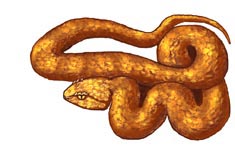

They are found in Mexico south through Central America into South America.
They live in wet lowland forests and rain forests, up in the trees mostly.
The feature that they are names for are several pointed scales over each eye that looks like eyelashes. They are typical pit-vipers with big triangle-shaped heads, up and down-shaped (vertical) pupils and pits between the nose holes (nostrils) and eyes that can sense heat (prey). They can be many colors, depending upon where they live. They can be yellow, orange, olive-green, tan, brown, or gray. They can have blotches or bands in different coloring. They are up to 2.5’ long. This is small compared to other rain forest snakes. They have the ability to wrap around branches and hold on (prehensile tail). This suits their life in the trees. They have sharp fangs that are quite poisonous. Their bites result in several deaths every year.
They are active at night (nocturnal). They live in the trees (arboreal). They often sit perched on above ground tree roots and watch for prey to come walking by.
They eat any small animal that comes across their path like lizards, frogs, small mammals and even birds and bats.
Females give birth to live young (viviparous). She can have up to 20 young in one litter.
Kingdom: Animalia
Phylum: Chordata
Class: Reptilia
Order: Squamata
Family: Viperidae
Genus: Bothriechis
Species: B. schlegelii
When you research information you must cite the reference. Citing for websites is different from citing from books, magazines and periodicals. The style of citing shown here is from the MLA Style Citations (Modern Language Association).
When citing a WEBSITE the general format is as follows.
Author Last Name, First Name(s). "Title: Subtitle of Part of Web Page, if appropriate." Title: Subtitle: Section of Page if appropriate. Sponsoring/Publishing Agency, If Given. Additional significant descriptive information. Date of Electronic Publication or other Date, such as Last Updated. Day Month Year of access < URL >.
Amsel, Sheri. "Snake (Eyelash Viper) " Exploring Nature Educational Resource ©2005-2024. December 14, 2024
< http://exploringnature.org/db/view/Snake-Eyelash-Viper- >

